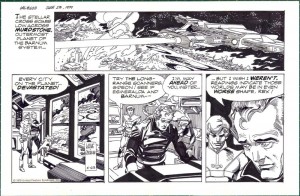The success of Star Wars, back in the late 1970s, did more than affect the movie industry. It even impacted the comic pages of newspapers.
For the first time in a long time, comic page editors were adding adventure strips to their line-ups. Most of them were based on well-known names; in addition to the Star Wars strip, Buck Rogers returned and a Star Trek strip premiered. There was at least one original strip during this period though, Star Hawks, which ran from 1977 to 1981.
The first creative team on Star Hawks was writer Ron Goulart and artist Gil Kane. Goulart is an established novelist, who, among his many solo credits, collaborated with William Shatner on the Tek War books. Kane, who died in 2000, was one of the artists who defined the look of DC’s super-hero comics in the late 1950s and early 1960s. (a.k.a. the Silver Age.)
Although the strip didn’t appear until after Star Wars arrived, work on Star Hawks actually began before the movie. Goulart has said in interviews that he was approached by an editor at the NEA syndicate to develop a new space opera series much was known about that galaxy far, far away. The sudden—and unexpected– success of SW , however, probably motivated NEA to offer the strip and produce it in an unusual format. Each installment of Star Hawks would be roughly twice the size of the average daily comic.
The average Star Hawks strip had four panels, while a standard strip had three. This may not sound like much of a difference, but it was enough to give an artist with Kane’s skills to produce some dynamic layouts. And when Kane and Goulart used fewer panels (as in one of the examples on this page), they could get a wide-screen effect similar to Star Wars.
So who were the Star Hawks? That was a nickname for the interplanetary law enforcement organization that policed the Barnum system, the setting of many of Goulart’s novels. Specifically, the title referred to agents Rex Jaxan and Chavez, a dashing hero and his flamboyant partner. Their beat, in the beginning was the planet Esmeralda, where they fought villains like Zakar, the dictator of Empire 13 and the ruthless Ilka Kandell.
The early stories are a clever mix of action and humor. Goulart’s trademark Robots With Attitude were out in force. Some of the jokes, however, may have been a little too inside; one supporting character, Finity Kwark, sounded like she had migrated from Dogpatch, the home of Li’l Abner. More importantly, Jaxan and Chavez, came across as being bland and superficial.
Some of this changed when Archie Goodwin took over as writer from Goulart (who says he quit due to disputes with the syndicate.) Under the name David Franklin, Goodwin had worked with Kane on at least two other projects: the science fantasy Blackmark and the spy thriller His Name is Savage. He also wrote quite a few Star Wars stories, both for the comic strip and the original Marvel run.
Goodwin’s first story for Star Hawks did its best to shake things up. We finally learn something about Jaxan’s background, as he travels to earth to resolve some unfinished business with his father figure. At roughly the same time, a little-known alien race called the Vyrlaks invade the Barnum system. Along with other naughtiness, the Vyrlaks destroy the Hoosegow, the space station that served as Jaxan and Chavez’s base, and kidnap Alice K. Benyon, their superior, and the woman Jaxan loves. He and Chavez are forced to relocate to a spaceship called the Stellar Cross.
But Star Hawks had more to worry about than the Vyrlaks. Shortly after these changes, the syndicate reduces the strip to one tier. (As someone who has worked on a number of newspapers, I can tell you that the strip’s unusual size probably made it more difficult to sell.) Goodwin was replaced by a writer named Roger McKenzie, but Kane stayed with the strip until it was cancelled.
Collections of the strip, along with two prose novels that Goulart wrote, can be found on Amazon. Despite its problems, Star Hawks was a valiant attempt to bring sf back to the comic pages.
ONE MORE THING: This is going to be my last blog for Amazing Stories for the foreseeable future. I want to thank Steve Davidson, for inviting me to get involved with Amazing’s revival, and everyone who took the time to read and comment on my posts.












